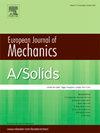Modeling metamaterials by second-order rate-type constitutive relations between only the macroscopic stress and strain
IF 4.2
2区 工程技术
Q1 MECHANICS
引用次数: 0
Abstract
We propose a thermodynamically based approach for constructing effective rate-type constitutive relations describing finite deformations of metamaterials. The effective constitutive relations are formulated as second-order in time rate-type Eulerian constitutive relations between only the Cauchy stress tensor, the Hencky strain tensor and objective time derivatives thereof. In particular, there is no need to introduce additional quantities or concepts such as “micro-level deformation”,“micromorphic continua”, “enriched continua”, or elastic solids with frequency dependent material properties. The linearisation of the proposed fully nonlinear (finite deformations) constitutive relations leads, in Fourier space, to the same constitutive relations as those commonly used in theories based on the concepts of frequency dependent density and/or stiffness. From this perspective the proposed constitutive relations reproduce the behaviour predicted by the frequency dependent density and/or stiffness models, but yet they work with constant — that is motion independent — material properties. Finally, we argue that the proposed fully nonlinear (finite deformations) second-order in time rate-type constitutive relations do not fall into traditional classes of models for elastic solids (hyperelastic solids/Green elastic solids, first-order in time hypoelastic solids), and that the proposed constitutive relations embody a new class of constitutive relations characterising elastic solids.
利用仅宏观应力和应变之间的二阶速率型本构关系对超材料进行建模
我们提出了一种基于热力学的方法来构建描述超材料有限变形的有效速率型本构关系。将有效本构关系表述为只有Cauchy应力张量、Hencky应变张量及其目标时间导数之间的二阶时间速率型欧拉本构关系。特别是,不需要引入额外的量或概念,如“微观变形”、“微形态连续体”、“富集连续体”或具有频率依赖材料特性的弹性固体。提出的完全非线性(有限变形)本构关系的线性化导致,在傅里叶空间中,与基于频率相关密度和/或刚度概念的理论中常用的本构关系相同。从这个角度来看,所提出的本构关系再现了频率相关密度和/或刚度模型所预测的行为,但它们与恒定的-即与运动无关的-材料特性一起工作。最后,我们认为所提出的完全非线性(有限变形)二阶时间速率型本构关系不属于弹性固体(超弹性固体/格林弹性固体,一阶时间次弹性固体)的传统模型类别,并且所提出的本构关系体现了表征弹性固体的新一类本构关系。
本文章由计算机程序翻译,如有差异,请以英文原文为准。
求助全文
约1分钟内获得全文
求助全文
来源期刊
CiteScore
7.00
自引率
7.30%
发文量
275
审稿时长
48 days
期刊介绍:
The European Journal of Mechanics endash; A/Solids continues to publish articles in English in all areas of Solid Mechanics from the physical and mathematical basis to materials engineering, technological applications and methods of modern computational mechanics, both pure and applied research.

 求助内容:
求助内容: 应助结果提醒方式:
应助结果提醒方式:


